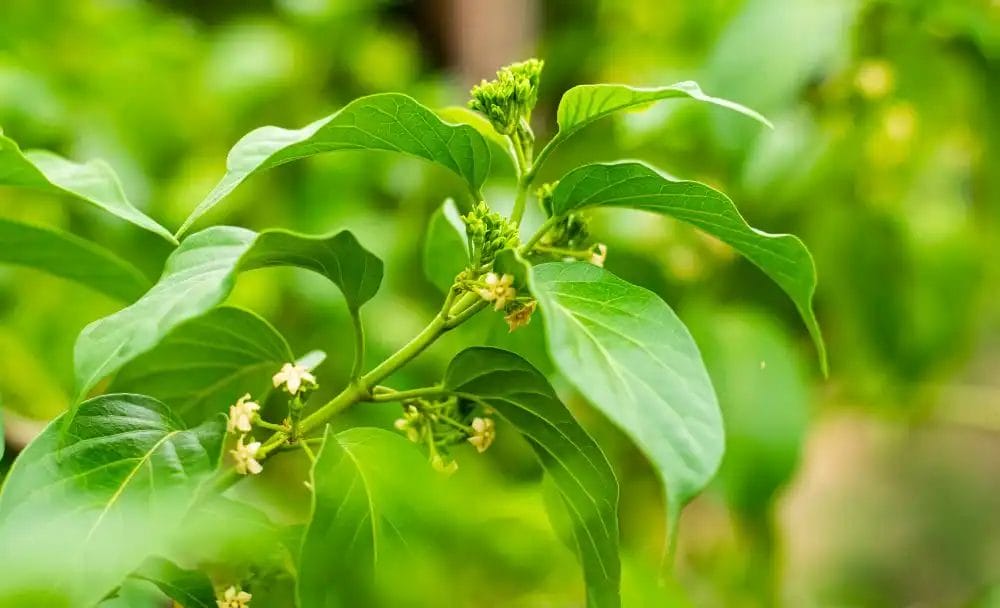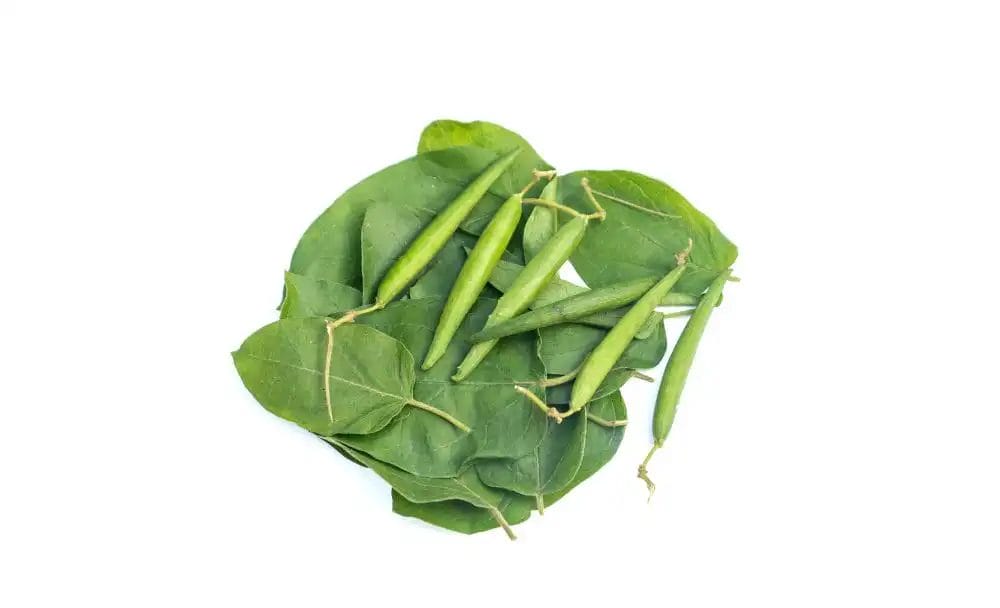
This article is reviewed by an expert
Gurmar/ Gudmad, also known as Gymnema sylvestre, is an incredible herb renowned for its ability as a “sugar destroyer” in the Ayurvedic system of medicine (1).
Gurmar’s secret lies in its phytoconstituents, such as triterpene saponins like gymnemic acids and gurmarin, which are responsible for its sweet suppression activity (1).
Gudmad offers a wide range of therapeutic effects, making it an effective natural remedy for diabetes. But its benefits don’t stop there! Gurmar is also used for managing arthritis and osteoporosis, supporting heart health, and even fighting microbial infections (1).
Let’s dig deeper into the many gurmar benefits and explore its potential in pharmacological applications in this article.
Nutritional Value of Gudmar [3]
Gudmar plant is bursting with several biochemical substances that are active and offer a plethora of health advantages.
Gymnemic acid A, B, C, and D triterpenoid saponins are present, along with sugar residues including glucuronic, galacturonic, ferulic, and angelic acids. In addition, betaine, choline, gymnamine alkaloids, inositol, and d-quercitol are present in the leaves.
Properties of Gudmar [4]
There are numerous gudmar plant benefits. Some of the beneficial properties of gudmar may include:
- It lowers blood sugar
- It lowers cholesterol
- Anti-inflammatory
- Promotes healthy weight
- Antimicrobial
- Anti-cancer
- Antioxidant
- Antiarthritic
- Wound healing
Benefits & Uses of Gurmar
1. Antidiabetic Property (1)
Primary Benefits: Gurmar helps regulate blood sugar levels due to the presence of triterpene saponins like gymnemic acids and gurmarin. Experimental trials on diabetic rats treated with Gurmar extracts showed a significant decrease in fasting blood glucose levels and a slight increase in body weight and protein levels.
Secondary Benefits: Additionally, Gurmar leaf extracts also possess antioxidant properties that help reduce lipid peroxidation and promote the scavenging of harmful radicals. This suggests that Gurmar may offer additional protection against diabetic complications.
2. Antiarthritic Activity (1)
Primary Benefits: Gurmar’s antiarthritic potential has been explored in albino rats, where its water-soluble and petroleum ether extracts effectively controlled arthritis.
Secondary Benefits: This action of Gurmar could be attributed to the presence of triterpenoids, steroids, and saponin glycosides, which also help in reducing inflammation and protecting joint cartilage and bone.
3. Dental Health (1)
Primary Benefits: Gurmar has shown significant efficacy against gram-positive cariogenic bacteria and Candida albicans, which are responsible for dental caries. Methanolic leaf extracts of Gurmar also exhibited potent activity against these harmful microbes.
Secondary Benefits: Based on this finding, Gurmar extracts can be used to form a herbal toothpaste with promising effects on dental caries.
4. Antibiotic and Antimicrobial Activity (1)
Primary Benefits: Various extracts of Gurmar have demonstrated antibiotic and antimicrobial activity against pathogens like Staphylococcus aureus, Escherichia coli, and Bacillus subtilis.
Secondary Benefits: These findings suggest that Gurmar holds potential as a natural remedy for microbial-related infections.
5. Anti-Inflammatory Activity (1)
Primary Benefits: Gurmar’s anti-inflammatory activity is attributed to bioactive compounds like tannins and saponins. In experimental studies, Gurmar leaf extracts effectively reduced paw oedema and granuloma in rats induced with inflammation.
Secondary Benefits: This property makes Gurmar a valuable candidate for managing inflammatory conditions, such as arthritis.
6. Anticancer and Cytotoxic Activity (1)
Primary Benefits: Certain saponins in Gurmar, including gymnemagenol, have shown significant anticancer activity against HeLa cancer cell lines in vitro.
Secondary Benefits: These saponins were found to inhibit the proliferation of cancer cells without affecting normal cells, making Gurmar a promising herb for cancer treatment.

7. Antihyperlipidemic Activity (1)
Primary Benefits: Gurmar has been found to reduce serum cholesterol levels, offering potential benefits in managing coronary artery disease and related disorders. Its triterpene saponins, particularly gymnemic acids, play a crucial role in this antihyperlipidemic activity.
Secondary Benefits: Gurmar leaf extracts have also exhibited antiobesity effects, making it a possible herbal medication for obesity management.
8. Immunostimulatory Activity (1)
Primary Benefits: Gurmar has been reported to possess immunostimulatory effects. Studies have shown that its aqueous leaf extract enhances the movement of neutrophils, chemotaxis, phagocytosis of Candida albicans, and nitroblue tetrazolium assays.
Secondary Benefits: This property suggests that Gurmar can help regulate immune responses and fight infections and diseases.
9. Hepatoprotective Activity (1)
Primary Benefits: Hydroalcoholic extract of Gurmar has demonstrated hepatoprotective effects against D-galactosamine-induced hepatotoxicity in rat hepatocytes.
Secondary Benefits: The extract also effectively restored altered biochemical parameters, further supporting Gurmar’s potential in promoting liver health.
10. Wound Healing Activity (1)
Primary Benefits: Gurmar’s alcoholic extract has shown remarkable wound-healing activity in clinical studies.
Secondary Benefits: This benefit is attributed to the presence of flavonoids which are also known to eliminate free radicals and support the healing process.
Traditional Uses of Gurmar
Gurmar is an ancient therapeutic herb with a long history of traditional use in various medicinal systems. It finds mention in Sushruta, an ancient medical text, as a remedy for glycosuria and urinary disorders. Gurmar’s multiple potentials have not just been recognized in Ayurveda but also in folk medicine and homoeopathic systems (2).
In Ayurveda, Gurmar has been traditionally used to treat diabetes, malaria, snake bites, diseases caused by phlegm, and piles. This remarkable herb is also prescribed for the treatment of various conditions, including dyspepsia, constipation, jaundice, haemorrhoids, renal and vesical calculi, cardiomyopathy, asthma, bronchitis, amenorrhea, and leucoderma (2).
Different parts of the Gurmar plant, such as roots, stem, and leaves, have been utilised in traditional medicine systems for their cardiotonic, digestive, diuretic, laxative, stimulant, stomachic, and uterine tonic properties. Various Indian tribes, including the Sahariya tribe of Madhya Pradesh, Junglee Irulas of Nilgiri hills, Kol tribe of Chhattisgarh, and the Nayaks of Karnataka, have relied on different parts of the Gurmar plant to treat asthma, eye and gastric problems, parkinsonism, urinary problems, and diabetes (2).
How to Use Gudmar [1]
Gudmar may be used as:
- Paste
- Powdered form
- Tablet
- Capsule
- Crude gudmar plant
Following your medical needs, your Ayurvedic doctor will recommend the appropriate form and dose. Furthermore, it’s advised to see an Ayurvedic physician before altering or stopping any current medications with any herbal or Ayurvedic treatments.
Dosage of Gurmar
The dosage of Gurmar depends on many factors, such as for what purpose it is being used, what is the medical history of the patient, what is the Prakriti and Dosha imbalance of the patient, etc.
Therefore, it is recommended to consult an Ayurvedic doctor before taking Gurmar and consume it in the prescribed dosage and manner.
Side Effects of Gurmar
Gurmar side effects are not well-known but it might cause hypoglycemia in both diabetic and non-diabetic patients. In one reported case, a patient also experienced drug-induced liver injury (DILI) after using Gymnema sylvestre for diabetes mellitus. Therefore, it is important to be vigilant about any signs of hypoglycemia or adverse effects while using Gurmar (2).
Precautions with Gurmar (2)
- People with diabetes or those using Gurmar to maintain normal sugar levels should regularly monitor their blood sugar levels to prevent hypoglycemia.
- If you have a history of liver conditions, it is advisable to exercise caution and consult a healthcare professional before using Gurmar.
- While Gurmar has shown relatively low toxicity in animal studies, it is still essential to follow recommended dosages to avoid potential adverse effects.
- As with any herb, it is always best to consult a healthcare professional before incorporating Gurmar into your health regimen, especially if yo
The Takeaway
Gurmar is an ancient herb with a wide range of therapeutic effects. It is a natural remedy for diabetes, arthritis, and osteoporosis, and it may also help fight microbial infections, support heart health, and promote wound healing.
However, it is important to note that Gurmar may cause hypoglycemia in both diabetic and non-diabetic patients. Therefore, you must consult an Ayurvedic doctor before incorporating Gurmar into your diet.
FAQs
1. How much Gurmar should I take?
The dosage of Gurmar depends on the individual and the condition being treated. It is important to consult with a physician or doctor to determine the correct dosage for you.
2. What are the best ways to take Gurmar?
Gurmar can be taken in a variety of ways, including capsules, extract and powder. However, the manner in which you should take Gurmar depends highly on your medical condition and therefore, it is recommended to consult an Ayurvedic doctor for the same.
3. Where can I buy Gurmar?
Gurmar is available in most health food stores, Ayurvedic pharmacies and online retailers.
References
- https://www.ncbi.nlm.nih.gov/pmc/articles/PMC3912882/
- https://www.ncbi.nlm.nih.gov/pmc/articles/PMC6830388/
- Mandal V,Dewanjee S, Mandal SC.Microwave‐assisted extraction of total bioactive saponin fraction from Gymnema sylvestre with reference to gymnemagenin: a potential biomarker.2009.
- In vitro studies in Gymnema sylvestre (Gudmar)-A high value medicinal plant. April 2023












